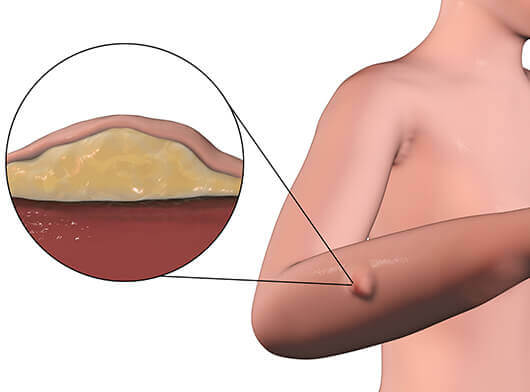- Surgery
- Radiation
- Medical Oncology
- Cryosurgery- Also known as Cryotherapy, this technique uses liquid nitrogen to freeze and destroy cancer cells. The technique may be repeated several times. The treated area may swell and blister and may be scarred after the wound heals. This is usually only used for small skin cancers or precancerous lesions.
- Excisional Surgery - The surgeon performs an excision with a scalpel or sharp razor, cutting or shaving a growth off the skin. The patient may receive local anaesthesia to numb the affected area. Excisions may leave a scar.
- Mohs Surgery- This technique is designed to remove skin cancer tumours while preserving as much healthy tissue as possible. In this procedure, cancerous cells are removed from the skin layer by layer until the removed layers show no sign of cancer cells. Mohs surgery is most often used on more visible areas, such as the head and neck or hands, to limit scarring. It may also be used on recurrent skin cancers. This surgery may receive local anaesthesia and may leave a scar.
- Reconstructive Surgery- Depending on the type of skin cancer and how much skin and tissue around the cancer need to be removed, reconstructive surgery may be recommended to replace the skin and tissue and minimise scarring.
- Curettage and Electrodesiccation - In this procedure, a skin lesion is removed with a curette, a long, thin surgical tool with a small, sharp hoop or scoop on Electrodesiccation scraping. After the lesion is scraped, the area is treated with an electric current through a needle-like electrode designed to kill remaining cancer cells and reduce bleeding. This is called electrodesiccation. This process of scraping and electrodesiccation may be repeated several times. It may require a local anaesthetic and may leave a scar.
- Lymph Node Biopsy and Removal - A lymph node biopsy is frequently performed on melanoma patients. In this procedure, your doctor will remove one or more specific lymph nodes, known as sentinel lymph nodes, which directly receive the lymph fluid draining from the tumour. If no sign of cancer is found in the lymph node or nodes, no additional lymph node surgery is necessary. If melanoma cells are found in one or more sentinel lymph nodes, the remaining lymph nodes in the region may be removed.
- Laser Surgery- This technique uses a laser beam, an intense, narrow beam of light, to destroy cancer cells. Laser surgery may be used to treat very superficial skin cancers.
- Surgery for Metastatic Skin Cancer- Basal cell and squamous cell carcinomas, which comprise more than 95 per cent of all skin cancers, usually don't metastasize. But melanoma, which accounts for about 2 per cent of all skin cancers, may travel to the brain, bones, liver and lungs. When that occurs, surgery may be performed to remove tumours from those locations. Surgery may need to be combined with other treatments, such as immunotherapy or chemotherapy, to treat metastatic cancer. In some cases, surgery for metastatic melanoma may be required to relieve symptoms of the disease.
- Radiation Therapy - Radiation therapy uses high-powered energy beams, such as X-rays to kill cancer cells. Radiation therapy may be an option when cancer can't be completely removed during surgery.
- Chemotherapy- In chemotherapy, drugs are used to kill cancer cells. For cancers limited to the top layer of skin, creams or lotions containing anti-cancer agents may be applied directly to the skin. Systemic chemotherapy can be used to treat skin cancers that have spread to other parts of the body.
- Photodynamic Therapy- This treatment destroys skin cancer cells with a combination of laser light and drugs that makes cancer cells sensitive to light.
- Immunotherapy- Immunotherapy uses your body's immune system to kill cancer cells.



.png)
